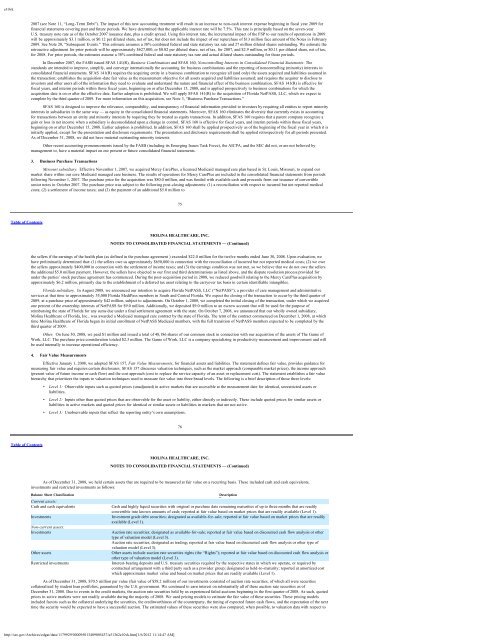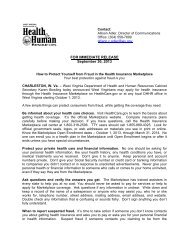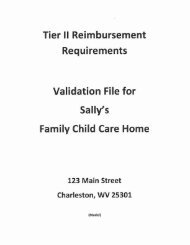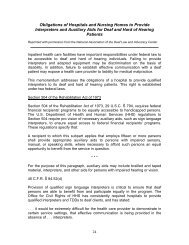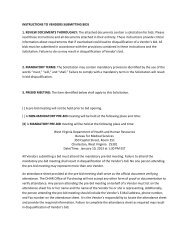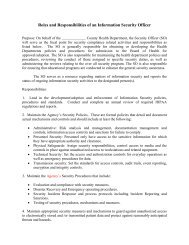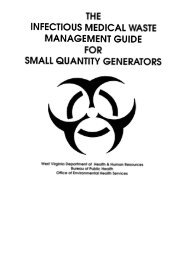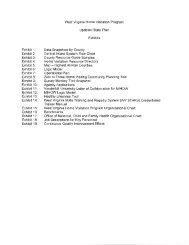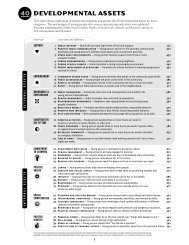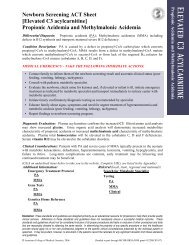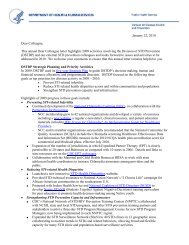Molina Medicaid Solutions - DHHR
Molina Medicaid Solutions - DHHR
Molina Medicaid Solutions - DHHR
Create successful ePaper yourself
Turn your PDF publications into a flip-book with our unique Google optimized e-Paper software.
e10vk2007 (see Note 11, “Long-Term Debt”). The impact of this new accounting treatment will result in an increase to non-cash interest expense beginning in fiscal year 2009 forfinancial statements covering past and future periods. We have determined that the applicable interest rate will be 7.5%. This rate is principally based on the seven-yearU.S. treasury note rate as of the October 2007 issuance date, plus a credit spread. Using this interest rate, the incremental impact of the FSP to our results of operations in 2009will be approximately $3.1 million, or $0.12 per diluted share, net of tax, but does not include the impact of our repurchase of $13 million face amount of the Notes in February2009. See Note 20, “Subsequent Events.” This estimate assumes a 38% combined federal and state statutory tax rate and 27 million diluted shares outstanding. We estimate theretroactive adjustment for prior periods will be approximately $627,000, or $0.02 per diluted share, net of tax, for 2007, and $2.9 million, or $0.11 per diluted share, net of tax,for 2008. For prior periods, the estimates assume a 38% combined federal and state statutory tax rate and actual diluted shares outstanding for those periods.In December 2007, the FASB issued SFAS 141(R), Business Combinations and SFAS 160, Noncontrolling Interests in Consolidated Financial Statements. Thestandards are intended to improve, simplify, and converge internationally the accounting for business combinations and the reporting of noncontrolling (minority) interests inconsolidated financial statements. SFAS 141(R) requires the acquiring entity in a business combination to recognize all (and only) the assets acquired and liabilities assumed inthe transaction; establishes the acquisition-date fair value as the measurement objective for all assets acquired and liabilities assumed; and requires the acquirer to disclose toinvestors and other users all of the information they need to evaluate and understand the nature and financial effect of the business combination. SFAS 141(R) is effective forfiscal years, and interim periods within those fiscal years, beginning on or after December 15, 2008, and is applied prospectively to business combinations for which theacquisition date is on or after the effective date. Earlier adoption is prohibited. We will apply SFAS 141(R) to the acquisition of Florida NetPASS, LLC, which we expect tocomplete by the third quarter of 2009. For more information on this acquisition, see Note 3, “Business Purchase Transactions.”SFAS 160 is designed to improve the relevance, comparability, and transparency of financial information provided to investors by requiring all entities to report minorityinterests in subsidiaries in the same way — as equity in the consolidated financial statements. Moreover, SFAS 160 eliminates the diversity that currently exists in accountingfor transactions between an entity and minority interests by requiring they be treated as equity transactions. In addition, SFAS 160 requires that a parent company recognize again or loss in net income when a subsidiary is deconsolidated upon a change in control. SFAS 160 is effective for fiscal years, and interim periods within those fiscal years,beginning on or after December 15, 2008. Earlier adoption is prohibited. In addition, SFAS 160 shall be applied prospectively as of the beginning of the fiscal year in which it isinitially applied, except for the presentation and disclosure requirements. The presentation and disclosure requirements shall be applied retrospectively for all periods presented.As of December 31, 2008, we did not have material outstanding minority interests.Other recent accounting pronouncements issued by the FASB (including its Emerging Issues Task Force), the AICPA, and the SEC did not, or are not believed bymanagement to, have a material impact on our present or future consolidated financial statements.3. Business Purchase TransactionsMissouri subsidiary. Effective November 1, 2007, we acquired Mercy CarePlus, a licensed <strong>Medicaid</strong> managed care plan based in St. Louis, Missouri, to expand ourmarket share within our core <strong>Medicaid</strong> managed care business. The results of operations for Mercy CarePlus are included in the consolidated financial statements from periodsfollowing November 1, 2007. The purchase price for the acquisition was $80.0 million, and was funded with available cash and proceeds from our issuance of convertiblesenior notes in October 2007. The purchase price was subject to the following post-closing adjustments: (1) a reconciliation with respect to incurred but not reported medicalcosts; (2) a settlement of income taxes; and (3) the payment of an additional $5.0 million to75Table of ContentsMOLINA HEALTHCARE, INC.NOTES TO CONSOLIDATED FINANCIAL STATEMENTS — (Continued)the sellers if the earnings of the health plan (as defined in the purchase agreement ) exceeded $22.0 million for the twelve months ended June 30, 2008. Upon evaluation, wehave preliminarily determined that: (1) the sellers owe us approximately $650,000 in connection with the reconciliation of incurred but not reported medical costs; (2) we owethe sellers approximately $400,000 in connection with the settlement of income taxes; and (3) the earnings condition was not met, so we believe that we do not owe the sellersthe additional $5.0 million payment. However, the sellers have objected to our first and third determinations as listed above, and the dispute resolution process provided forunder the parties’ stock purchase agreement has commenced. During the post-acquisition period in 2008, we reduced goodwill relating to the Mercy CarePlus acquisition byapproximately $6.2 million, primarily due to the establishment of a deferred tax asset relating to the carryover tax basis in certain identifiable intangibles.Florida subsidiary. In August 2008, we announced our intention to acquire Florida NetPASS, LLC (“NetPASS”), a provider of care management and administrativeservices at that time to approximately 55,000 Florida MediPass members in South and Central Florida. We expect the closing of the transaction to occur by the third quarter of2009, at a purchase price of approximately $42 million, subject to adjustments. On October 1, 2008, we completed the initial closing of the transaction, under which we acquiredone percent of the ownership interests of NetPASS for $9.0 million. Additionally, we deposited $9.0 million to an escrow account that will be used for the purpose ofreimbursing the state of Florida for any sums due under a final settlement agreement with the state. On October 7, 2008, we announced that our wholly owned subsidiary,<strong>Molina</strong> Healthcare of Florida, Inc., was awarded a <strong>Medicaid</strong> managed care contract by the state of Florida. The term of the contract commenced on December 1, 2008, at whichtime <strong>Molina</strong> Healthcare of Florida began its initial enrollment of NetPASS <strong>Medicaid</strong> members, with the full transition of NetPASS members expected to be completed by thethird quarter of 2009.Other. On June 30, 2008, we paid $1 million and issued a total of 48,186 shares of our common stock in connection with our acquisition of the assets of The Game ofWork, LLC. The purchase price consideration totaled $2.3 million. The Game of Work, LLC is a company specializing in productivity measurement and improvement and willbe used internally to increase operational efficiency.4. Fair Value MeasurementsEffective January 1, 2008, we adopted SFAS 157, Fair Value Measurements, for financial assets and liabilities. The statement defines fair value, provides guidance formeasuring fair value and requires certain disclosures. SFAS 157 discusses valuation techniques, such as the market approach (comparable market prices), the income approach(present value of future income or cash flow) and the cost approach (cost to replace the service capacity of an asset or replacement cost). The statement establishes a fair valuehierarchy that prioritizes the inputs to valuation techniques used to measure fair value into three broad levels. The following is a brief description of those three levels:• Level 1: Observable inputs such as quoted prices (unadjusted) in active markets that are accessible at the measurement date for identical, unrestricted assets orliabilities.• Level 2: Inputs other than quoted prices that are observable for the asset or liability, either directly or indirectly. These include quoted prices for similar assets orliabilities in active markets and quoted prices for identical or similar assets or liabilities in markets that are not active.• Level 3: Unobservable inputs that reflect the reporting entity’s own assumptions.76Table of ContentsMOLINA HEALTHCARE, INC.NOTES TO CONSOLIDATED FINANCIAL STATEMENTS — (Continued)As of December 31, 2008, we held certain assets that are required to be measured at fair value on a recurring basis. These included cash and cash equivalents,investments and restricted investments as follows:Balance Sheet Classification DescriptionCurrent assets:Cash and cash equivalentsCash and highly liquid securities with original or purchase date remaining maturities of up to three months that are readilyconvertible into known amounts of cash; reported at fair value based on market prices that are readily available (Level 1).InvestmentsInvestment grade debt securities; designated as available-for-sale; reported at fair value based on market prices that are readilyavailable (Level 1).Non-current assets:InvestmentsAuction rate securities; designated as available-for-sale; reported at fair value based on discounted cash flow analysis or othertype of valuation model (Level 3).Auction rate securities; designated as trading; reported at fair value based on discounted cash flow analysis or other type ofvaluation model (Level 3).Other assetsOther assets include auction rate securities rights (the “Rights”); reported at fair value based on discounted cash flow analysis orother type of valuation model (Level 3).Restricted investmentsInterest-bearing deposits and U.S. treasury securities required by the respective states in which we operate, or required bycontractual arrangement with a third party such as a provider group; designated as held-to-maturity; reported at amortized costwhich approximates market value and based on market prices that are readily available (Level 1).As of December 31, 2008, $70.5 million par value (fair value of $58.2 million) of our investments consisted of auction rate securities, of which all were securitiescollateralized by student loan portfolios, guaranteed by the U.S. government. We continued to earn interest on substantially all of these auction rate securities as ofDecember 31, 2008. Due to events in the credit markets, the auction rate securities held by us experienced failed auctions beginning in the first quarter of 2008. As such, quotedprices in active markets were not readily available during the majority of 2008. We used pricing models to estimate the fair value of these securities. These pricing modelsincluded factors such as the collateral underlying the securities, the creditworthiness of the counterparty, the timing of expected future cash flows, and the expectation of the nexttime the security would be expected to have a successful auction. The estimated values of these securities were also compared, when possible, to valuation data with respect tohttp://sec.gov/Archives/edgar/data/1179929/000095013409005437/a51362e10vk.htm[1/6/2012 11:14:47 AM]


